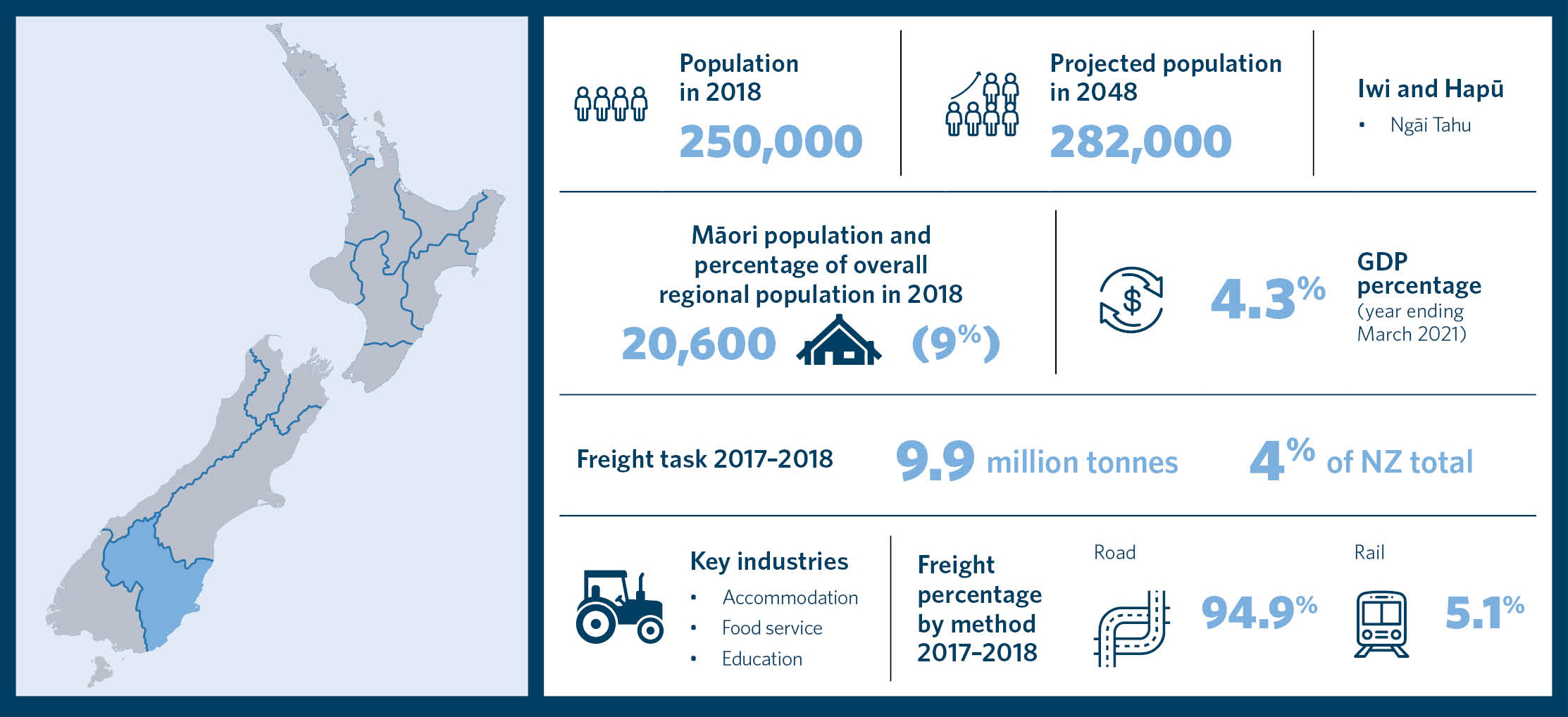At a glance

Arataki Ōtākou – Otago regional direction [PDF, 2.3 MB]
Arataki Ōtākou – Otago statistics table - infographic alternative [PDF, 112 KB]
The September 2023 v1.1 release of Arataki includes updates to reflect the severe weather events of 2023 and make minor corrections.
Ōtākou Otago is the country’s second largest region by land area. It has a population of just under 250,000 and is expected to grow to about 282,000 by 2048. Ōtepoti Dunedin is the region’s largest urban centre, but Tāhuna Queenstown is the fastest growing area.
The economy of Ōtākou is dominated by the accommodation, food service, and education sectors; this reflects the importance of regional tourism and Ōtepoti as a tertiary centre of excellence. Safe and reliable access to Port Otago and the airports in Ōtepoti and Tāhuna is important for the economies of Ōtākou and Murihiku Southland.
The region’s transport network has enough capacity to meet current and future demand, although the scale of growth in Tāhuna means transformational change is needed in coming decades. While public transport use has grown in Ōtepoti and Tāhuna, private vehicles still dominate across the region.
The number of deaths and serious injuries in Ōtākou is high, with issues on high-risk rural roads, at high-risk urban intersections, and in urban areas with many deaths and serious injuries involving pedestrians and cyclists.
Resilience also needs to be a focus, with coastal flooding expected to increase in the southern parts of Ōtepoti and other coastal areas.
Focusing our efforts
For efficient and effective progress, transport challenges in Ōtākou Otago must be tackled in a cohesive way. The directions below identify the most important issues to be resolved over the next 10 years to make progress towards transport outcomes.
- Begin to reduce vehicle kilometres travelled, focusing on Tāhuna Queenstown and Ōtepoti Dunedin, in a way that’s equitable and improves people’s quality of life.
- Plan and deliver growth and urban development, especially in rapidly growing Tāhuna, in an affordable and cost-effective way that aligns with emissions-reduction goals.
- Maintain and improve the resilience and efficiency of road and rail connections to surrounding regions and the Port Otago.
- Improve access to social and economic opportunities, especially by public transport, walking, and cycling.
- Provide better access for tourists in Tāhuna and opportunities created by the new Dunedin Hospital.
- Significantly reduce the harm caused by the transport system of Ōtākou, especially through improved road safety and reduced pollutants dangerous to health.
- Encourage growth and development in areas that already have good travel choices and shorter average trip lengths, like working with Queenstown Lakes District Council (QLDC) and central government to implement the Queenstown Lakes Spatial Plan.
- Rapidly accelerate the delivery of walking and cycling networks, predominantly through reshaping existing streets, to make these options safe and attractive.
- Improve and expand public transport services, including exploring the potential for new and emerging technologies, such as on-demand services, to improve access to social and economic opportunities.
- Better understand the impact of future economic transformation on travel patterns and freight volumes.
- Explore opportunities to move to a multimodal freight system with greater use of rail and coastal shipping.
- Continue support of the Milford Opportunities Project to encourage resilience, tourism, safety, and mode shift for the Milford corridor, and surrounding region.
- Confirm how resilience risks will be addressed over time, and work with communities to plan for when to defend, accommodate, or retreat.
- Continue to implement road safety plans and programmes including those focused for iwi Māori.
- Improve or maintain, as appropriate, physical access to marae, papakāinga wāhi tapu, and wāhi taonga.
These will be updated over time to focus effort on the most critical matters.
Arataki Ōtākou – Otago regional direction [PDF, 2.3 MB]
